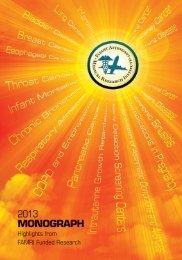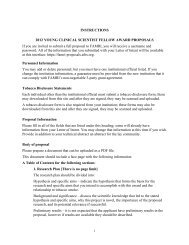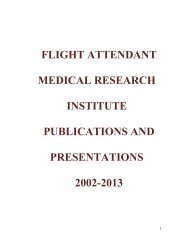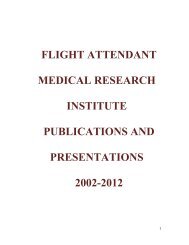MISSION
2009 compendium of FAMRI-supported research - Flight Attendant ...
2009 compendium of FAMRI-supported research - Flight Attendant ...
You also want an ePaper? Increase the reach of your titles
YUMPU automatically turns print PDFs into web optimized ePapers that Google loves.
consumer acceptance through Web-based surveys. The findings of this research will provide data to inform<br />
strategies to communicate public health risks of PREPs, and develop important guidelines for sidestream<br />
smoke emissions.<br />
SMOKE-FREE AIR LAWS, EXPOSURE AND HEALTH IN ADOLESCENTS<br />
Gregory N. Connolly, DMD, MPH; Harvard School of Public Health; CIA 2008<br />
Every day, more than 15 million children are exposed to SHS at home, with millions also exposed in day<br />
care centers, schools, restaurants, and other places. Scientific evidence shows causal relationships between<br />
exposure to SHS and a range of developmental and respiratory effects in neonates, infants, children, and<br />
adolescents. Children exposed to SHS are at an increased risk for sudden infant death syndrome, acute<br />
respiratory infections, ear problems, and more severe asthma. SHS exposure among children has decreased<br />
substantially since 1992-1993 when the national prevalence of households with smoke-free home rules was<br />
43% and less than one percent of the US population was protected by 100% smoke-free workplace<br />
standards. Eliminating smoking in indoor spaces fully protects non-smokers from SHS, yet no evidence has<br />
been reported to demonstrate reductions in pediatric diseases resulting from these declines in SHS<br />
exposure of children. Dr. Connolly hypothesizes that reductions in SHS exposure of children are associated<br />
with fewer SHS-caused pediatric illnesses and reduced utilization of health services. To investigate this<br />
hypothesis he will examine the association between SHS exposure of children in the home and SHS-related<br />
pediatric diagnoses and symptoms in all US health care settings and the association between SHS exposure<br />
of children in the home and health services utilization for treatment of SHS-related pediatric diagnoses and<br />
symptoms in all US health care settings. He will use a cross-sectional observational design involving<br />
secondary data analysis of existing national and state-level data sets. The outcome measures will be SHSrelated<br />
pediatric diagnoses and symptoms and health services utilization for treatment of SHS-related<br />
pediatric diagnoses and symptoms. The exposure measures will be percentage of households with an adult<br />
smoker and any children, percentage of households with smoking restrictions, percentage of households<br />
with an adult smoker, with smoking allowed and any children, percentage of children exposed to SHS in<br />
the home, percentage of population coverage with comprehensive smoke-free workplace rules, and<br />
percentage of coverage with smoke-free day care centers standards. The outcome measurements will be<br />
obtained from the National Ambulatory Medical Care Survey, the National Hospital Ambulatory Medical<br />
Care Survey, and the Healthcare Cost and Utilization Project Kids’ Inpatient Database. The exposure<br />
measurements will be determined from the Behavioral Risk Factor Surveillance System and Current<br />
Population Survey-Tobacco Use Supplements, and wll be analyzed by analysis of variance and multivariable<br />
regression modeling.<br />
Dr. Connolly used data from the 1999-2006 National Health and Nutrition Examination Survey, a<br />
cross-sectional survey designed to monitor the health and nutritional status of the US population, to<br />
investigate the association between smoke-free standards coverage and SHS exposure among non-smoking<br />
youths (3-19 years) in the US. Serum cotinine levels were available for 11,486 non-smoking youths from<br />
117 survey locations. Each location was categorized into one of three groups indicating extensive, partial,<br />
and no coverage by a smoke-free law. SHS exposure was defined as having serum cotinine levels greater<br />
than or = 0.05 ng/ml. In addition, cotinine was analyzed as a continuous outcome for years 2003-2006.<br />
Among non-smoking youths living in counties with extensive smoke-free law coverage, 32.7% were<br />
exposed to SHS, compared with 49.5% with partial coverage, and 64.7% with no standards. Adjusting for<br />
covariates, youths residing in counties with extensive coverage had 0.31 times the odds of SHS exposure<br />
and youths with partial coverage had 0.58 times the odds of SHS exposure compared to those residing in<br />
counties without smoke-free standards. These results suggest that smoke-free standards are an effective<br />
strategy for reducing SHS exposure not only in adults, but in youth as well.<br />
TOBACCO SMOKE ENDOTOXIN<br />
Lennart P. Larsson, PhD; Lund University; CIA 2007<br />
Recent research has shown that tobacco smoke contains large amounts of bacterial lipopolysaccharides<br />
(LPS, endotoxin), a family of inflammatory toxins from Gram-negative bacteria known to cause severe<br />
respiratory disease upon inhalation. By using gas chromatography-mass spectrometry technology Dr.<br />
Larsson measured LPS-specific 3-hydroxy fatty acids, peptidoglycan-specific muramic acid, and fungalspecific<br />
ergosterol in cigarettes of 37 brands purchased in six different countries in Europe and Asia and in<br />
10 brands of American cigarettes purchased in the US. The PI found that: 1) “light” and “full flavor”<br />
cigarettes do not differ with respect to the microbial components mentioned; 2) the levels of some of these<br />
components, mainly ergosterol, were comparatively low in certain local Asian brands of cigarettes; 3) the<br />
1 8 0 P A G E







